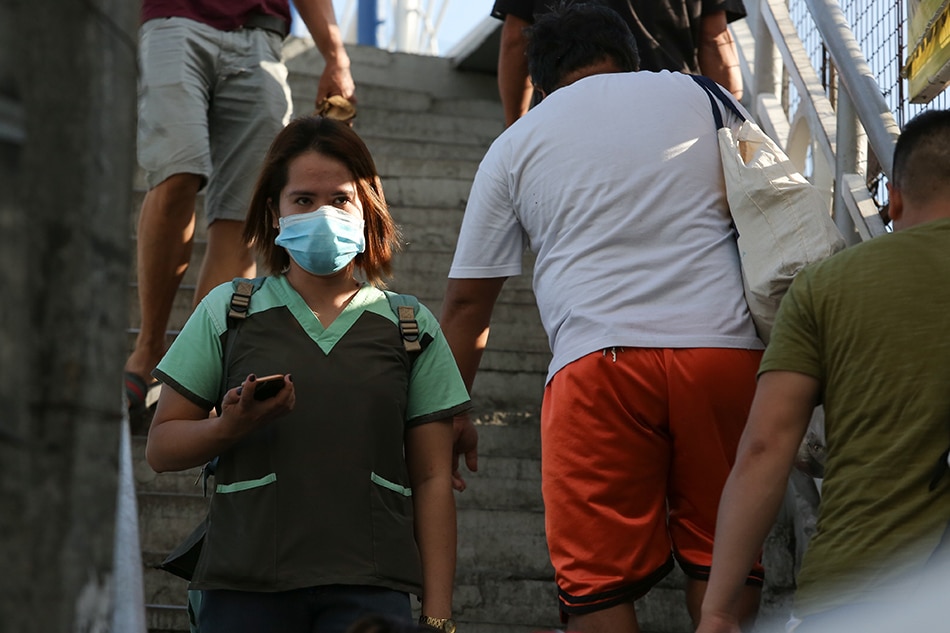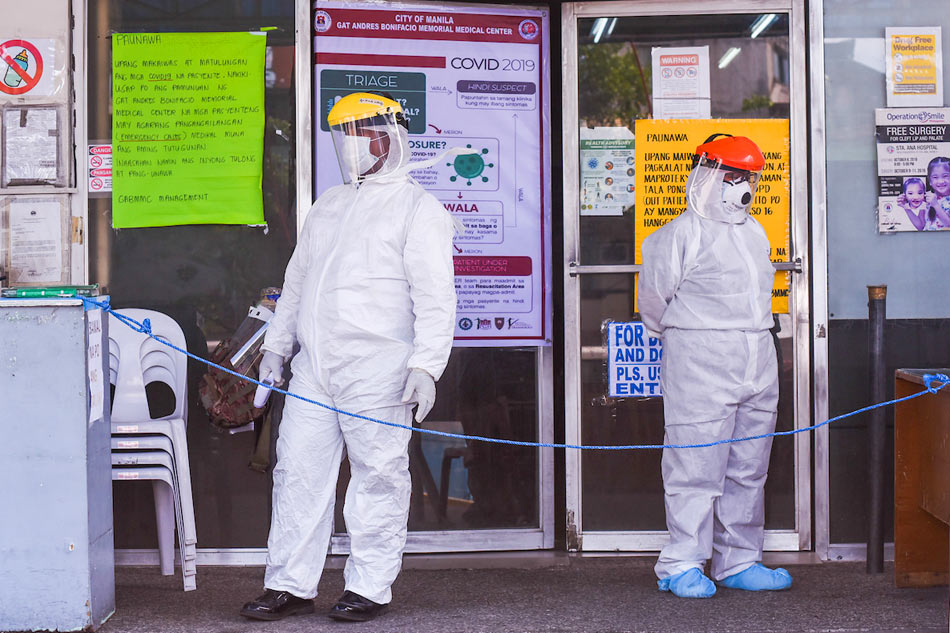Life after lockdown: Gov't readies Luzon for 'new normal' after quarantine | ABS-CBN
ADVERTISEMENT

Welcome, Kapamilya! We use cookies to improve your browsing experience. Continuing to use this site means you agree to our use of cookies. Tell me more!
Life after lockdown: Gov't readies Luzon for 'new normal' after quarantine
Life after lockdown: Gov't readies Luzon for 'new normal' after quarantine
Arianne Merez,
ABS-CBN News
Published Apr 01, 2020 04:53 PM PHT
|
Updated Apr 01, 2020 05:26 PM PHT
MANILA - Millions in the Philippines will need to adapt to a "new normal" at the end of a lockdown to defeat the coronavirus pandemic, government officials said Tuesday as they prepared measures for a post-quarantine scenario.
MANILA - Millions in the Philippines will need to adapt to a "new normal" at the end of a lockdown to defeat the coronavirus pandemic, government officials said Tuesday as they prepared measures for a post-quarantine scenario.
Luzon, home to roughly half of the Philippines' 100-million population, was placed under a month-long quarantine on March 17 as people were told to stay at home to control the spread of the new coronavirus disease (COVID-19).
Luzon, home to roughly half of the Philippines' 100-million population, was placed under a month-long quarantine on March 17 as people were told to stay at home to control the spread of the new coronavirus disease (COVID-19).
Other provinces outside the main northern island group have also restricted movement to contain the outbreak.
Other provinces outside the main northern island group have also restricted movement to contain the outbreak.
"It's far from over dahil habang wala pa ngang vaccine ito, ito na nga 'yung sinasabi nating new normal (while there is no vaccine yet, this is what we call the new normal)," Cabinet Secretary Karlo Nograles said Wednesday.
"It's far from over dahil habang wala pa ngang vaccine ito, ito na nga 'yung sinasabi nating new normal (while there is no vaccine yet, this is what we call the new normal)," Cabinet Secretary Karlo Nograles said Wednesday.
ADVERTISEMENT
Officials have yet to say whether the lifting of the lockdown will push through as scheduled on April 13 as it leaves the assessment to a technical working group led by the Department of Health.
Officials have yet to say whether the lifting of the lockdown will push through as scheduled on April 13 as it leaves the assessment to a technical working group led by the Department of Health.
The National Economic and Development Authority, meanwhile, is leading efforts "to revive consumer and business confidence even sooner," said Socioeconomic Planning Secretary Ernesto Pernia.
The National Economic and Development Authority, meanwhile, is leading efforts "to revive consumer and business confidence even sooner," said Socioeconomic Planning Secretary Ernesto Pernia.
Millions of poor families for the meantime are dependent on relief aid while waiting for a cash subsidy from the national government.
Millions of poor families for the meantime are dependent on relief aid while waiting for a cash subsidy from the national government.
GRADUAL LIFTING?
Among options being considered by the government is a barangay or village-based quarantine to pave the way for a gradual lifting of the lockdown.
Among options being considered by the government is a barangay or village-based quarantine to pave the way for a gradual lifting of the lockdown.
Under such scenario, the reopening of essential businesses such as those involved in the supply chain of food products, medical products, and other necessities will be prioritized, according to Trade Secretary Ramon Lopez.
Under such scenario, the reopening of essential businesses such as those involved in the supply chain of food products, medical products, and other necessities will be prioritized, according to Trade Secretary Ramon Lopez.
ADVERTISEMENT
"Gradual muna, importante mabalik 'yung mga negosyo na kailangan magtuloy para po may hanapbuhay ang ating mga kababayan, again following the new norm, 'yung social distancing," he said.
"Gradual muna, importante mabalik 'yung mga negosyo na kailangan magtuloy para po may hanapbuhay ang ating mga kababayan, again following the new norm, 'yung social distancing," he said.
(It should be gradual. It's important for businesses to resume operations so that people can go to work, again following the new norm, social distancing.)
(It should be gradual. It's important for businesses to resume operations so that people can go to work, again following the new norm, social distancing.)
Once businesses are allowed to resume, Lopez said companies must adopt a "new culture," which includes physical distancing and avoiding mass gatherings.
Once businesses are allowed to resume, Lopez said companies must adopt a "new culture," which includes physical distancing and avoiding mass gatherings.
Marketing, construction and public transportation should also resume with safeguards to prevent the spread of COVID-19, said Presidential Adviser on Entrepreneurship Joey Concepcion.
Marketing, construction and public transportation should also resume with safeguards to prevent the spread of COVID-19, said Presidential Adviser on Entrepreneurship Joey Concepcion.
"The goal really is while we have to be guarded against the virus, we have to start reviving the economy. We might kill the virus but we might die because the economy is floundering. That's the biggest challenge we're facing right now," Concepcion said.
"The goal really is while we have to be guarded against the virus, we have to start reviving the economy. We might kill the virus but we might die because the economy is floundering. That's the biggest challenge we're facing right now," Concepcion said.
ADVERTISEMENT
QUARANTINE FACILITIES
More Filipinos are expected to be tested for COVID-19 in the coming days after the health department announced that it could now run 1,000 tests a day from the previous daily average of 300.
More Filipinos are expected to be tested for COVID-19 in the coming days after the health department announced that it could now run 1,000 tests a day from the previous daily average of 300.
With more cases of the disease expected to be confirmed in the coming days, Nograles said the government is preparing a system of segregation to isolate patients who will test positive for COVID-19 and patients under investigation (PUIs).
With more cases of the disease expected to be confirmed in the coming days, Nograles said the government is preparing a system of segregation to isolate patients who will test positive for COVID-19 and patients under investigation (PUIs).
The government is turning its convention centers into "fully-functional" quarantine facilities. It is also looking at ships and hotels as alternative quarantine sites, as more hospitals become overwhelmed with the rising number of COVID-19 cases.
The government is turning its convention centers into "fully-functional" quarantine facilities. It is also looking at ships and hotels as alternative quarantine sites, as more hospitals become overwhelmed with the rising number of COVID-19 cases.
In 10 days, the Philippine International Convention Center, World Trade Center, and the Rizal Memorial Sports Complex will be converted into quarantine facilities.
In 10 days, the Philippine International Convention Center, World Trade Center, and the Rizal Memorial Sports Complex will be converted into quarantine facilities.
Each region, meanwhile, has prepared a hotel that could be dedicated as an exclusive COVID-19 quarantine facility.
Each region, meanwhile, has prepared a hotel that could be dedicated as an exclusive COVID-19 quarantine facility.
ADVERTISEMENT
Nograles explained that the government is planning to allot hospitals for COVID-19 patients who are in a severe or critical state to ensure adequate medical treatment.
Nograles explained that the government is planning to allot hospitals for COVID-19 patients who are in a severe or critical state to ensure adequate medical treatment.
Those who will test positive for the disease but will exhibit mild symptoms, meanwhile, will be isolated "as a group" to avoid overcrowding in hospitals, he said.
Those who will test positive for the disease but will exhibit mild symptoms, meanwhile, will be isolated "as a group" to avoid overcrowding in hospitals, he said.
"We have to make sure that the hospital bed capacity is intact...We have to prioritize severe and critical patients," Nograles added.
"We have to make sure that the hospital bed capacity is intact...We have to prioritize severe and critical patients," Nograles added.
Patients under investigation or those who have symptoms of the disease but are still waiting for their test results have to be isolated in a facility fit for "single-room occupancy," Nograles said.
As for persons under monitoring, or those who were exposed to COVID-19 patients but are still asymptomatic, the Cabinet official said the government is also looking for a way to isolate them from the public.
Patients under investigation or those who have symptoms of the disease but are still waiting for their test results have to be isolated in a facility fit for "single-room occupancy," Nograles said.
As for persons under monitoring, or those who were exposed to COVID-19 patients but are still asymptomatic, the Cabinet official said the government is also looking for a way to isolate them from the public.
"Ang gusto lang po natin ma-manage ay 'yung hindi siya kakalat ng ganoon ka-widespread at lahat ng mahahawa ng COVID-19 ay naaalagaan natin at mas madami tayong recovery kaysa death," Nograles said.
"Ang gusto lang po natin ma-manage ay 'yung hindi siya kakalat ng ganoon ka-widespread at lahat ng mahahawa ng COVID-19 ay naaalagaan natin at mas madami tayong recovery kaysa death," Nograles said.
ADVERTISEMENT
(We want to manage the spread of the disease. We want to ensure that everyone who gets infected with COVID-19 will be taken care of. We want more recoveries than deaths.)
(We want to manage the spread of the disease. We want to ensure that everyone who gets infected with COVID-19 will be taken care of. We want more recoveries than deaths.)
TRANSITION
But even if the government sets up massive quarantine facilities and lifts the lockdown, Filipinos still need to be wary of the possibility of getting infected with COVID-19 since there is no available vaccine or cure for the disease yet.
But even if the government sets up massive quarantine facilities and lifts the lockdown, Filipinos still need to be wary of the possibility of getting infected with COVID-19 since there is no available vaccine or cure for the disease yet.
"Kahit mag-transition na tayo doon sa new normal, kailangan naka-implement pa 'yung mga social distancing measures. Kailangan maingat pa rin tayo dahil habang nandiyan pa yung threat ng COVID-19 at wala pa pong vaccine, kailangan lagi po tayong mag-iingat," Nograles said.
"Kahit mag-transition na tayo doon sa new normal, kailangan naka-implement pa 'yung mga social distancing measures. Kailangan maingat pa rin tayo dahil habang nandiyan pa yung threat ng COVID-19 at wala pa pong vaccine, kailangan lagi po tayong mag-iingat," Nograles said.
(Even as we transition to the new normal, we have to still implement social distancing measures. We need to be careful because as long as the COVID-19 threat is there and there is no vaccine, we always need to be careful.)
(Even as we transition to the new normal, we have to still implement social distancing measures. We need to be careful because as long as the COVID-19 threat is there and there is no vaccine, we always need to be careful.)
For now, government policy is erring on the side of caution as it depends on science to guide its next move.
For now, government policy is erring on the side of caution as it depends on science to guide its next move.
ADVERTISEMENT
"It will be based on science. It will be based on numbers. It will be based on facts and figures and it would totally depend on the cooperation of everybody," Nograles said.
"It will be based on science. It will be based on numbers. It will be based on facts and figures and it would totally depend on the cooperation of everybody," Nograles said.
Read More:
coronavirus Philippines lockdown
Luzon lockdown
Luzon enhanced community quarantine
Philippines coronavirus lockdown
Philippines coronavirus quarantine
Philippines COVID-19 lockdown
Karlo Nograles Luzon lockdown
Ramon Lopez economic impact coronavirus
ADVERTISEMENT
ADVERTISEMENT





